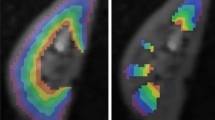Abstract
Synthetic magnetic resonance imaging (MRI) allows the production of images with any contrast from a single scan after quantification. The combined T2-weighted image (T2WI) and fluid-attenuated inversion recovery (FLAIR) image is expected to have an improved contrast between the normal-appearing white matter (WM) and WM lesion (WML). The purpose of this study was to determine whether optimal T2 contrast-weighted images (SyFLAIR3) comprising the combined T2WI and FLAIR image generated using synthetic MRI could improve contrast in the WM region. Numerical simulations were performed to estimate the contrast-to-noise ratio (CNR) between the WM and WML and cerebrospinal fluid (CSF) ratio at any echo time (TE) using SyFLAIR3. The CNR and CSF ratio for SyFLAIR3 was compared with those for FLAIR and double inversion recovery (DIR) images in ten volunteers. In numerical simulations, the CNR for SyFLAIR3 was increased in the T2WI and FLAIR images with long TEs, and the CSF ratio was decreased on those with short TEs. An in vivo study indicated that the CNR for SyFLAIR3 using T2WI and FLAIR images with an optimized combination of TEs was significantly higher than those for FLAIR and DIR images; whereas, the CSF ratio for the optimized SyFLAIR3 was not significantly different from that for the FLAIR images. The use of SyFLAIR3 improves the contrast within the region of the WM without the need for additional scanning in synthetic MRI.





Similar content being viewed by others
References
Polman CH, Reingold SC, Banwell B, et al. Diagnostic criteria for multiple sclerosis: 2010 revisions to the McDonald criteria. Ann Neurol. 2011;69:292–302.
Simon JH, Li D, Traboulsee A, et al. Standardized MR imaging protocol for multiple sclerosis: consortium of MS centers consensus guidelines. Am J Neuroradiol. 2006;27:455–61.
Bachmann R, Reilmann R, Schwindt W, et al. FLAIR imaging for multiple sclerosis: a comparative MR study at 1.5 and 3.0 T. Eur Radiol. 2006;16:915–21.
Stevenson VL, Parker GJ, Barker GJ, et al. Variations in T1 and T2 relaxation times of normal appearing white matter and lesions in multiple sclerosis. J Neuro Sci. 2000;178:81–7.
Miller DH, Johnson G, Tofts PS, et al. Precise relaxation time measurements of normal-appearing white matter in inflammatory central nervous system disease. Magn Reson Med. 1989;11:331–6.
Armspach JP, Gounot D, Rumbach L, et al. In vivo determination of multiexponential T2 relaxation in the brain of patients with multiple sclerosis. Magn Reson Imaging. 1991;9:107–13.
Hagiwara A, Hori M, Yokoyama K, et al. Utility of a multiparametric quantitative MRI model that assesses myelin and edema for evaluating plaques, periplaque white matter, and normal-appearing white matter in patients with multiple sclerosis: a feasibility study. Am J Neuroradiol. 2017;38:237–42.
Granberg T, Uppman M, Hashim F, et al. Clinical feasibility of synthetic MRI in multiple sclerosis: a diagnostic and volumetric validation study. Am J Neuroradiol. 2016;37:1023–9.
Blystad I, Warntjes JB, Smedby O, et al. Synthetic MRI of the brain in a clinical setting. Acta Radiol. 2012;53:1158–63.
Wattjes MP, Lutterbey GG, Gieseke J, et al. Double inversion recovery brain imaging at 3 T: diagnostic value in the detection of multiple sclerosis lesions. Am J Neuroradiol. 2007;28:54–9.
Geurts JJ, Pouwels PJ, Uitdehaag BM, et al. Intracortical lesions in multiple sclerosis: improved detection with 3D double inversion-recovery MR imaging. Radiology. 2005;236:254–60.
Redpath W, Smith W. Use of a double inversion recovery pulse sequence to image selectively grey or white brain matter. Br J Radiol. 1994;67:1258–63.
Warntjes JB, Leinhard OD, West J, et al. Rapid magnetic resonance quantification on the brain: optimization for clinical usage. Magn Reson Med. 2008;60:320–9.
Hagiwara A, Warntjes M, Hori M, et al. SyMRI of the brain: rapid quantification of relaxation rates and proton density, with synthetic MRI, automatic brain segmentation, and myelin measurement. Investig Radiol. 2017;52:647.
Hagiwara A, Hori M, Yokoyama K, et al. Synthetic MRI in the detection of multiple sclerosis plaques. Am J Neuroradiol. 2016;38:257–63.
Wiggermann V, Hernández-Torres E, Traboulsee A, et al. FLAIR2: a combination of FLAIR and T2 for improved MS lesion detection. Am J Neuroradiol. 2016;37:259–65.
Sati P, George IC, Shea CD, et al. FLAIR*: a combined MR contrast technique for visualizing white matter lesions and parenchymal veins. Radiology. 2012;265:926–32.
Gabr RE, Hasan KM, Haque ME, et al. Optimal combination of FLAIR and T2-weighted MRI for improved lesion contrast in multiple sclerosis. J Magn Reson. 2016;44:1293–300.
Acknowledgements
The authors would like to thank Yoshiyuki Ishimori, PhD, for his useful suggestions. This study was supported in part by Grant-in-Aid for Scientic Research (C) from Japan Society for the Promotion of Science (Grant no. 15K09916).
Author information
Authors and Affiliations
Corresponding author
Ethics declarations
Conflict of interest
The authors declare no conflict of interest.
Ethical approval
Statements of human rights: All procedures performed in studies involving human participants were in accordance with the ethical standards of our Institutional Review Board (IRB) and 1964 Helsinki Declaration and its later amendments or comparable ethical standards. Statements of animal rights: This article does not contain any studies performed on animals.
Informed consent
Informed consent was obtained from each participant included in this study.
Additional information
Publisher’s Note
Springer Nature remains neutral with regard to jurisdictional claims in published maps and institutional affiliations.
About this article
Cite this article
Fujiwara, Y., Inoue, Y., Kanamoto, M. et al. The use of combined T2-weighted and FLAIR synthetic magnetic resonance images to improve white matter region contrast: a feasibility study. Radiol Phys Technol 12, 118–125 (2019). https://doi.org/10.1007/s12194-019-00498-7
Received:
Revised:
Accepted:
Published:
Issue Date:
DOI: https://doi.org/10.1007/s12194-019-00498-7




